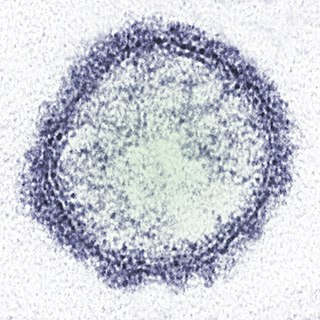
Arbovirus is an informal name for any virus that is transmitted by arthropod vectors. The term arbovirus is a portmanteau word. Tibovirus is sometimes used to more specifically describe viruses transmitted by ticks, a superorder within the arthropods. Arboviruses can affect both animals and plants. In humans, symptoms of arbovirus infection generally occur 3–15 days after exposure to the virus and last three or four days. The most common clinical features of infection are fever, headache, and malaise, but encephalitis and viral hemorrhagic fever may also occur.

Bunyavirales is an order of segmented negative-strand RNA viruses with mainly tripartite genomes. Member viruses infect arthropods, plants, protozoans, and vertebrates. It is the only order in the class Ellioviricetes. The name Bunyavirales derives from Bunyamwera, where the original type species Bunyamwera orthobunyavirus was first discovered. Ellioviricetes is named in honor of late virologist Richard M. Elliott for his early work on bunyaviruses.
Bwamba orthobunyavirus (BWAV) belongs to the genus Orthobunyavirus and the order Bunyavirales RNA viruses. BWAV is present in large parts of Africa, endemic in Mozambique, Tanzania and Uganda. It is transmitted to humans through mosquito bites and results in a brief benign generalised infection with headache, skin rash, diarrhea and joint pain and lasts 4–5 days. The animal reservoir of the virus includes birds, monkeys and donkeys.

Oropouche fever is a tropical viral infection transmitted by biting midges and mosquitoes from the blood of sloths to humans. This disease is named after the region where it was first discovered and isolated at the Trinidad Regional Virus Laboratory in 1955 by the Oropouche River in Trinidad and Tobago. Oropouche fever is caused by a specific arbovirus, the Oropouche virus (OROV), of the Bunyaviridae family.

Orthobunyavirus is a genus of the Peribunyaviridae family in the order Bunyavirales. There are currently ~170 viruses recognised in this genus. These have been assembled into 103 species and 20 serogroups.
Bunyamwera orthobunyavirus (BUNV) is a negative-sense, single-stranded enveloped RNA virus. It is assigned to the Orthobunyavirus genus, in the Bunyavirales order.

Schmallenberg orthobunyavirus, also called Schmallenberg virus, abbreviated SBV, is a virus that causes congenital malformations and stillbirths in cattle, sheep, goats, and possibly alpaca. It appears to be transmitted by midges, which are likely to have been most active in causing the infection in the Northern Hemisphere summer and autumn of 2011, with animals subsequently giving birth from late 2011. Schmallenberg virus falls in the Simbu serogroup of orthobunyaviruses. It is considered to be most closely related to the Sathuperi and Douglas viruses.
Tete orthobunyavirus is a bunyavirus found originally in Tete Province, Mozambique. It is a disease of animals and humans. Two forms, Bahig and Matruh viruses, were isolated from bird ticks including Hyalomma marginatum, but elsewhere mosquitoes and biting midges have been implicated as vectors.

Emaravirus is a genus of negative-strand RNA viruses which infect plants. The plant virus group is the sole genus in the family Fimoviridae. The genus has 21 species.
The 63U-11 virus (63UV) is a strain of Marituba virus in the genus Orthobunyavirus.
The 75V-2621 virus is a strain of Gamboa virus in the genus Bunyavirus. It was first isolated in the mosquito Aedeomyia squamipennis in Vinces, Ecuador in 1974. Ad. squamipennis appears to be the vector and birds a host, including the chicken Gallus gallus domesticus under experimental conditions. It has only been isolated in the tropical regions of Central and South America. It has not be shown to cause disease in humans, or domestic and wild animals; however, in a 2018 study, antibodies against the Gamboa virus were found in birds (6.2%), humans (1.5%), and other wild animals (2.6%).
Abras orthobunyavirus, also called Abras virus (ABRV), is a species of virus in the genus Orthobunyavirus. Isolated from Culex adamesi and C. paracrybda in Ecuador. Not reported to cause disease in humans.
Acara orthobunyavirus (ACAV) is a species in the genus Orthobunyavirus, belonging to the Capim serogroup. It is isolated from sentinel mice, Culex species, and the rodent Nectomys squamipes in Pará, Brazil and in Panama. The symptoms of the Acará virus is death. Sometimes reported to cause disease in humans.
Tahyna orthobunyavirus ("TAHV") is a viral pathogen of humans classified in the California encephalitis virus (CEV) serogroup of the Orthobunyavirus family in the order Bunyavirales, which is endemic to Europe, Asia, Africa and possibly China.
Cache Valley orthobunyavirus (CVV) is a member of the order Bunyavirales, genus Orthobunyavirus, and serogroup Bunyamwera, which was first isolated in 1956 from Culiseta inornata mosquitos collected in Utah's Cache Valley. CVV is an enveloped arbovirus, nominally 80–120 nm in diameter, whose genome is composed of three single-stranded, negative-sense RNA segments. The large segment of related bunyaviruses is approximately 6800 bases in length and encodes a probable viral polymerase. The middle CVV segment has a 4463-nucleotide sequence and the smallest segment encodes for the nucleocapsid, and a second non-structural protein. CVV has been known to cause outbreaks of spontaneous abortion and congenital malformations in ruminants such as sheep and cattle. CVV rarely infects humans, but when they are infected it has caused encephalitis and multiorgan failure.
Jamestown Canyon encephalitis is an infectious disease caused by the Jamestown Canyon virus, an orthobunyavirus of the California serogroup. It is mainly spread during the summer by different mosquito species in the United States and Canada.
Tensaw orthobunyavirus is a virus in the genus Orthobunyavirus of the Bunyamwera arbovirus group, order Bunyavirales. It is named for the river bordering the area in south Alabama where the prototype strain was discovered. It is abbreviated TEN, TENV, and TSV in the scientific literature.

Peribunyaviridae is a family of viruses in the order Bunyavirales. Its name partially derives from Bunyamwera, Uganda, where the founding species was first isolated.
Anhembi is a Brazilian municipality in the state of São Paulo. It can also refer to:





